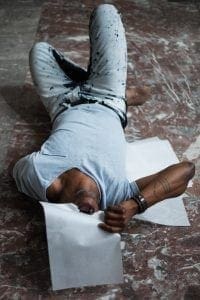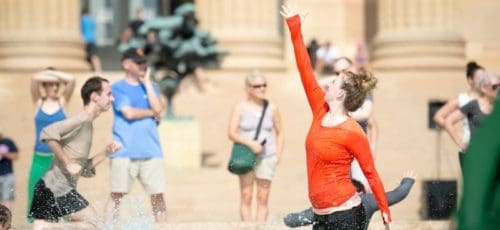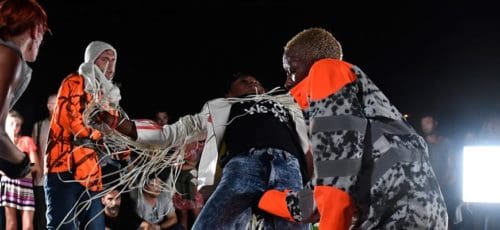Something to Chew On: Boris Charmatz on manger
Boris Charmatz subjects dance to formal constraints which redefine the field of its possibilities: a potentially infinite canon of gestures in his 2016 Fringe Festival piece Levée des conflits, inert bodies of children, animated by adult dancers in enfant. The stage is a notepad where he jots down ideas and organic concepts in order to observe the chemical reactions, the intensities, and the tensions engendered in their encounter. In manger, the center of gravity was subject to displacement: how to set bodies in motion not with the eyes, or with the limbs, but with the mouth? Gilles Amalvi talked to Boris Charmatz in 2013 about the ideas behind this delectable contemporary work.
 Featured in the 2018 Fringe Festival, manger is presented in partnership with Westphal College of Media Arts & Design as part of Philadelphia Museum of Dance.
Featured in the 2018 Fringe Festival, manger is presented in partnership with Westphal College of Media Arts & Design as part of Philadelphia Museum of Dance.
Gilles Amalvi: An important starting idea for you was the “not very spectacular” dimension of the action of eating, swallowing. Is this line of thought still relevant?
Boris Charmatz: Absolutely. The creation, as I now see it, increasingly tends towards a form of disappearance: treating food in terms of swallowing it, blotting it out. But then, this calls for careful, precise planning, very unlike the rather raw principle that I had initially envisaged. To tackle the dimension of disappearance, the dimension of blockage, of impediment—in speaking, dancing—I find some subtle, precise mechanisms, bordering on invisibility in order not to just dangle in front of the audience a vision of bodies in the process of ingesting.
Gilles Amalvi: You evoke your earlier pieces Levée des conflits and enfant in manger. Do you intend connections with principles derived in earlier pieces?
Boris Charmatz: Indeed. This piece is not a synthesis, nor the conclusion to a trilogy, but I think that those pieces contain principles corresponding to two types of desire, to two ways of constructing dance, that find a way to intermingle in manger.
It also feels the influence of another previous piece. I focus on the question of what a choreography of mouths, of hands, and of feet, might be, in the sense that the stage is a sort of a “table.” Strangely enough, as I was working with this material, images from an older piece, Herses, came back to me. Herses contains a lot of gestures that are quite “unrestrained,” involving a play between presence and absence. In the end, eating is an extremely concrete action, but perhaps those who perform it are only partly there, they’re not fully conscious of the act. There is nothing demonstrative in our way of eating, rather a form of half-absence, ghostly in character. Perhaps this is due to the fact of being divided between two actions: we are half-eating and half-dancing.
There are few moments in the performance when there is only one thing visible on the stage. Very quickly, other things appear, adopting the matrix of a duo from Herses, except while eating —the idea is that you can do anything you want, as long as you do it while eating.
Gilles Amalvi: Did you discuss with the dancers the ideas of eating off the ground, of exchanging food, of how food touches upon our taboos?
Boris Charmatz: Quite right, we have talked about it. There are dancers who are not going to take part in this piece for that very reason. This raises issues of hygiene, of diet, of a balanced diet, of sharing…Can eight people bite into the same apple? Eat off the ground? These are questions of culture and individual choice.
Gilles Amalvi: If you think about it from the strict point of view of dance, food is an obstacle: it encumbers your hands, then, when you’re digesting, it encumbers your body. I have the impression that you feel the need to impose a constraint, an obstacle as the driving force of choreography. A way of “blocking” what is easy, obvious about dance.
Boris Charmatz: Yes, it’s true. For me, the whole question resides in knowing what parallel effect this creates. Food as an obstacle has no meaning unless it makes possible or generates another thing. For example: dancing with a child in your arms is a hindrance, but it generates movements that would not have been otherwise possible.
In dance, few things happen through the mouth — it is mainly used to breathe. More often than not, you try to keep it closed, out of an “aesthetic” convention. Without going into the impersonal “masks” in modern dance or the grimaces in German expressionist dance, it can be said that the mouth is rarely the point of departure for movement. The choreography of this whole piece is tied to the mouth; it comes together in a relation of distance and proximity with the mouth. Just as Levée de conflits begins by the gesture of scrubbing the floor in a circular manner, this piece arises out of the relation between the hand, food and the mouth. This is the matrix that engenders other ways of eating — and dancing.
Gilles Amalvi: The sheets of paper activate the mouth and set eating in motion, all the while dispensing with the images associated with food, the idea of a “blowout meal”…
Boris Charmatz: Indeed, we are working at a metaphoric level. Eating is a way of digesting reality—in the end, not unlike dance which is a way of digesting gestures, attitudes. These leaves are made up of white sheets—not sheets printed with text.
I experimented with other types of “neutral” food, like for example cotton candy. It carries a festive, fairground connotation, but it’s essentially a woolly material that you can shape at will. You can eat it in large quantities, and there is hardly anything in your mouth. But on the other hand, it’s terrible for your teeth and your health—it’s nothing but sugar. Otherwise, I could easily imagine whole clouds of cotton candy. This performance raises the question of desire, of taste: the first day, when you serve roasted chicken and cotton candy, it’s all well and good. But the next day, and the day after that, it’s going to be nauseating.
Gilles Amalvi: Your approach to dance has something of a global enterprise: a choreographic work containing a “retrospective” dimension, a self-made and self-dissolved installation. Does this correspond to the “museum of dance” that is being developed in your work?
Boris Charmatz: I have always tried to set up a strict framework within which I could do whatever I wanted.
On this occasion, food on the stage remains a big unknown—which entails other unknowns—even if, strictly speaking, I could have just settled on remaking Levée des conflits with eating and singing. The idea is to make a choreographic, malleable sound object that is infused with different layers of noise.
Gilles Amalvi: Isn’t it what this is about: being able to absorb everything, while successfully setting parameters to the chaos engendered by this “everything”?
Boris Charmatz: Yes, and it’s also the idea of not starting out by “creating a vacuum” as one is often used to do in dance. Not to start out with an empty studio where there is breathing room for the gesture, but rather to work with a mass. To refine the framework of “eating, singing, moving,” to dig into it, as if it were a sculpture. Out of chaos, out of the plethora, to release a casket, something refined and complex…I think that’s what this is about.
— Introductory text by Christopher Munden
What: manger
When: September 22 + 23, 2018
Where: FringeArts, 140 North Columbus Boulevard
Cost: $15 – $35
Created by Boris Charmatz
FringeArts.com/8081
Photos by Beniamin Boar and Ursula Kaufmann




